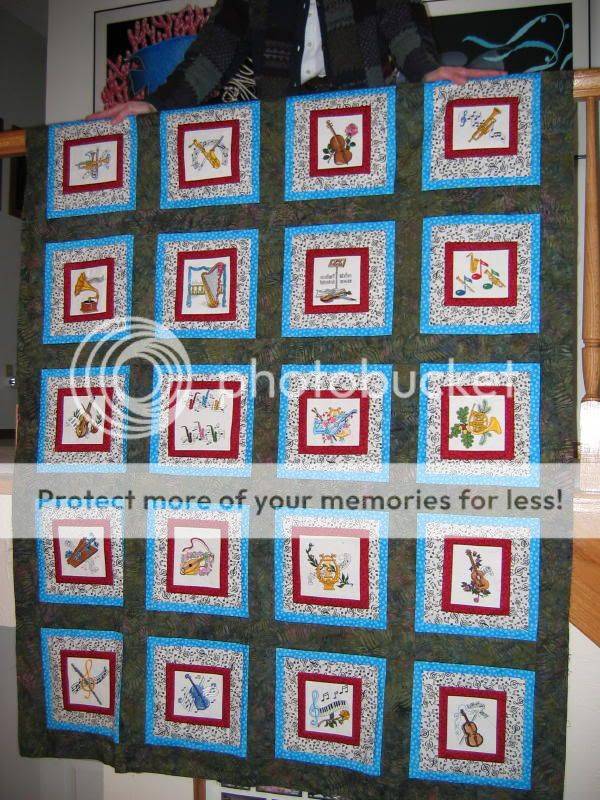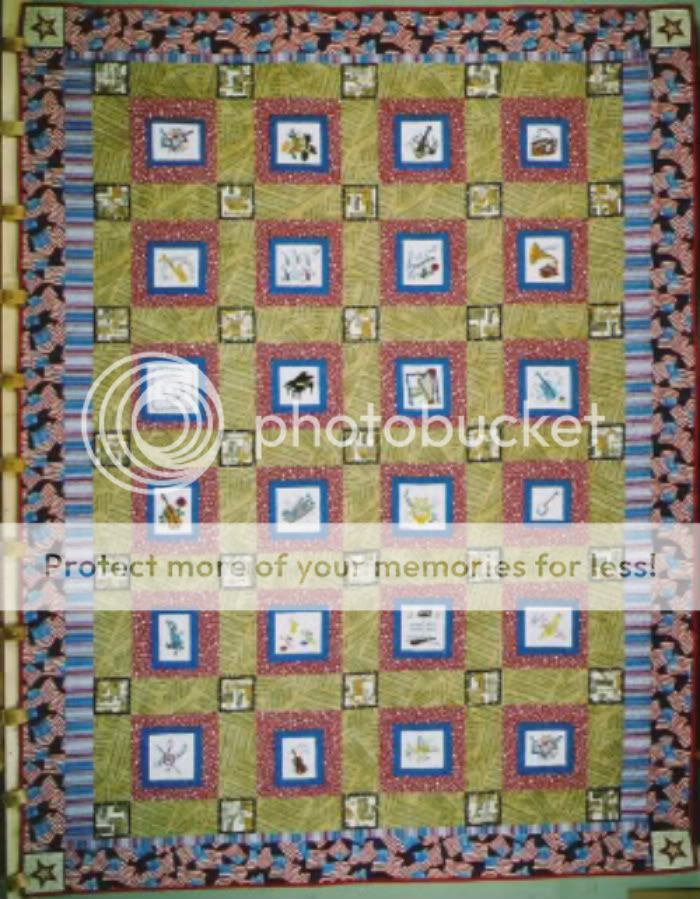Thanks. It was my pick of about 15 different renditions on engineering paper, most of which were truly and thoroughly BAD. A couple were so bad they were shocking.
Judging by your other fine works, Becki, I think only
you would think they are "shocking" bad.
Your hard work is well matched to your kind heart. Good job on the designs. Do you ever scan them and put them on the web as .pdf files or sell them?
Thanks, DW, but to explain it a different way, saying "quilts" is like saying "painting." You can paint a house or an object, or you can use the word to describe all the 2-D surface objects you saw at the Hermitage Museum, St. Petersburg on your cruise of the Baltic. That would mean you took in an indescribably rare painting of DaVinci or Russia's collection of Rembrandt paintings, of which there are only one less in number than in all of Amsterdam.
The term "quilt" encompasses a lot of different techniques--piecing, applique, making a comforter, or simply quilting two pieces of solid color cloth to make a statement in shadows created by the slight gathering of hand stitching through 3 layers of cloth. If you break down applique, you can include different fields of endeavor--hand dyed, printed, or percale cloths needle-turned delicately into shapes of tradition, your own designs, or a likeness of a Rembrandt painting. You can use a machine or hand satin stitch, blanket stitch, or any of a myriad of traditional or cutting edge, self-designed embroidery master stitches to attach the applique to a background. You can make or embellish another kind of quilt with embroidery as in a redwork. The list of methods, products, and know-how of appliquing one fabric to another is endless, just like the different types of other fine art media.
In piecing, the same is true, and if he were still here, M.C.Escher might be pleased to know his paintings have inspired quilters to do changeling one-patch shapes that fly across the quilt like his pen-and-ink look black and whites did on canvas, unmarred by anything except perfect junctures in which fabrics may have been machine or hand-stitched together with precision quarter inch seam allowances. There are star pieced quilts, album block pieced quilts, bargello pieced quilts, hexagonal grandmother's flower garden pieced, curved 2-patch pieced, wedding ring, half-square triangular-pieced, quarter-squares, if you get my drift.
The dog quilt is a simple example of a postage stamp effort that resulted in a square block. When I charted out my graphs, I'd never tried to create a simply-shaped dog before, so naturally, I started out as though I were going to do a painting. To do justice to a Scottie, I'd have to create a quilt top with 20,000 half-inch squares and spend the next 2 years scouring the world for preprinted cotton fabric or dye my own, which I refuse to do. I thought about size, and of course, it was to be a little hugs quilt, so the parameter would naturally be a 40x60 inch work, give or take a dozen inches either way. Scotties, like daschunds, are visually wider than long, and I needed a way to fit over a child's body on a charity quilt. Knowing the child's mother would either not use the quilt if it were too elaborate, the 20,000 piece idea was thrown under the bus. The 40x60 idea would result in 2,400 pieces, and that would have taken a minimum of 6 months after two months of designing someone else's photograph, which would be dishonest artistically. My other recourse would be to design a square and repeat it a few times to come out well, with not too many squares on the design. The first design was taller than it was wide, and after doing a 30 hour search online, I found someone else had used what I thought I'd just "created," which told me to get back to the drawing board and do a simple square that would fit a 12-inch block perfectly, which means the user of my pattern could take her square and combine it with a world of 12" finished squares that are out there in traditional quilt land. So I went back to the drawing board with that in the back of my mind, and proceeded to go off topic, seeing if a decent Scotty could be done with just one large square. ((((((gong!!!)))))) If that were ever to be, I realized, I was not the artist to meet a challenge half way. My filled-in squares ranged from ugly to terrible to a remote likeness of a godzilla-like creature, not from Scotland, either. I remembered about the goal of the 12" square after realizing nothing was working after dozens of tries on the mid-range square idea. I sketched one out. Too tall. Another. Too long. Another, then decided to downsize. The first time I drew the final choice, I kind of liked it, but was on an improvement tear, so I kept on going. I continued my obsession for a long time, but nothing panned out that convinced me other people might like this one too. I kept looking back over at the other little dog that seemed moderately ok. Then I realized what was wrong. The squares I'd filled in were confused on account of value issues. On that particular shape, you needed dark values to define what you would like to bring out in the scottie. I took the same squares, took it to a blank page, and did two more mock ups, each with a little different values on defining squares. I took it to cloth using 1.75" unfinished squares and strips of 1.75" in the backgrounds in various links to make the 12.5" unfinished (which finishes to exactly 12.0" when joined to sash pieces). I sewed it out. It looked like it had no chin, but it did resemble a Scotty. I took out some of the browns and put black prints in the chin and other defined areas. It wasn't my usual arrangement for placing darks strategically, but it worked for that block.
I made chinless scotty into a senior pillow and donated it to Barb the go-to-senior-home gal to give to someone who'd like it. I worked hard selecting pretty sash fabrics so that at least it would be a pleasure to someone's eye. I was really pleased, even though only I knew the flaw which was less distinguished after setting it as described, but the earlier apparition was still a flagman stopping traffic to my eye.
After refining and doing more Scotty blocks, I had 4 to go. I'd chewed up a couple of weeks just getting it acceptable. The blocks just looked better if the fabrics in key areas of definition were blacker than the other prints. Only one of the blocks wasn't entirely as pleasing as the others. I left it to be my obvious flaw. Traditionally, quilters always made on square wrong on purpose in order to show their belief that God alone is perfect, and we should not go overboard on perfection, but be the imperfect beings we are, so the obvious flaw can be seen in many an early American quilt top pieced or applique. In my tradition of working on a quilt, this conservative's attitude is progressive. I just keep "progressing" until it's finished, and the imperfection stays.

A great artist of impeccable taste would see what I did, but he would also know of the tradition of the obvious flaw in quilting if he were that well-read. Others might not see my obvious flaw, but someone someday will notice and hopefully, forgive it in honor of our mothers who believed in being human and not worrying so much about being perfect is a good rule of thumb to live by.
And that's how the quilt top came about. I did not see the finished quilt, do not know what the charity bees did with the top, the recipient, or whether they elected to sell it to purchase battings for other charity quilts, and I don't want to know. I made it for a poor child. Others are in charge of seeing to it that child gets a nice work for the problems he or she has seen in her or his young life. My dear husband has dementia and cannot remember how to take pictures any more, so one of my sewing sisters unbeknownst to me, took a pic of two ladies hanging it up on the bulletin board so several ladies could copy the pattern when it showed up on the bees memo to members. That's how I got a copy of the pic to send here. It's all I have except for the scraps and extra fabric I had left over to make another, possibly for a relative. Since the photograph is not all that clear in discerning dark colors from black, I will have to place squares on a cloth board, leave the room for a day, and come back the next day to figure out if it will be clear enough to have the same impact as the first quilt had.
In the meantime, I have some other charity quilt projects going, and it may be a year before I get back to the Scottie project. The fabrics are safe in clear plastic storage containers with hopefully leak-proof lids until that time comes around. Next time I will make an effort to find and use the digital camera I bought but am frightened of. My last effort to take a picture was when we visited the Golden Gate Bridge at San Fran Bay. The clouds were hugging the bridge like Carl Sandberg's poem like "little cat's feet." The brilliant orange posts were beautifully surrounded by the wisps, so beautiful and present "snap" when the clicker. When the picture came back, I had two ugly poles sticking out of a white mass. It couldn't have been less aesthetic. I haven't done photography since. So camera's are objects of yuk to me now and likely forever.
If you're still reading, at least one of us is awake. It's nite nite time for me.
Best wishes, everyone & have a lovely evening.
My heart goes out to the families of those dear Navy Seals who gave their lives for country by trying to find and rescue a fellow Seal who was trapped somewhere in Afghanistan's mountain terrain. May God himself comfort the families of the 38 soldiers, from here and abroad, who died in the attack. And may he comfort all the loved ones of American soldiers who have passed in the line of or as a result of their duty to this country.












